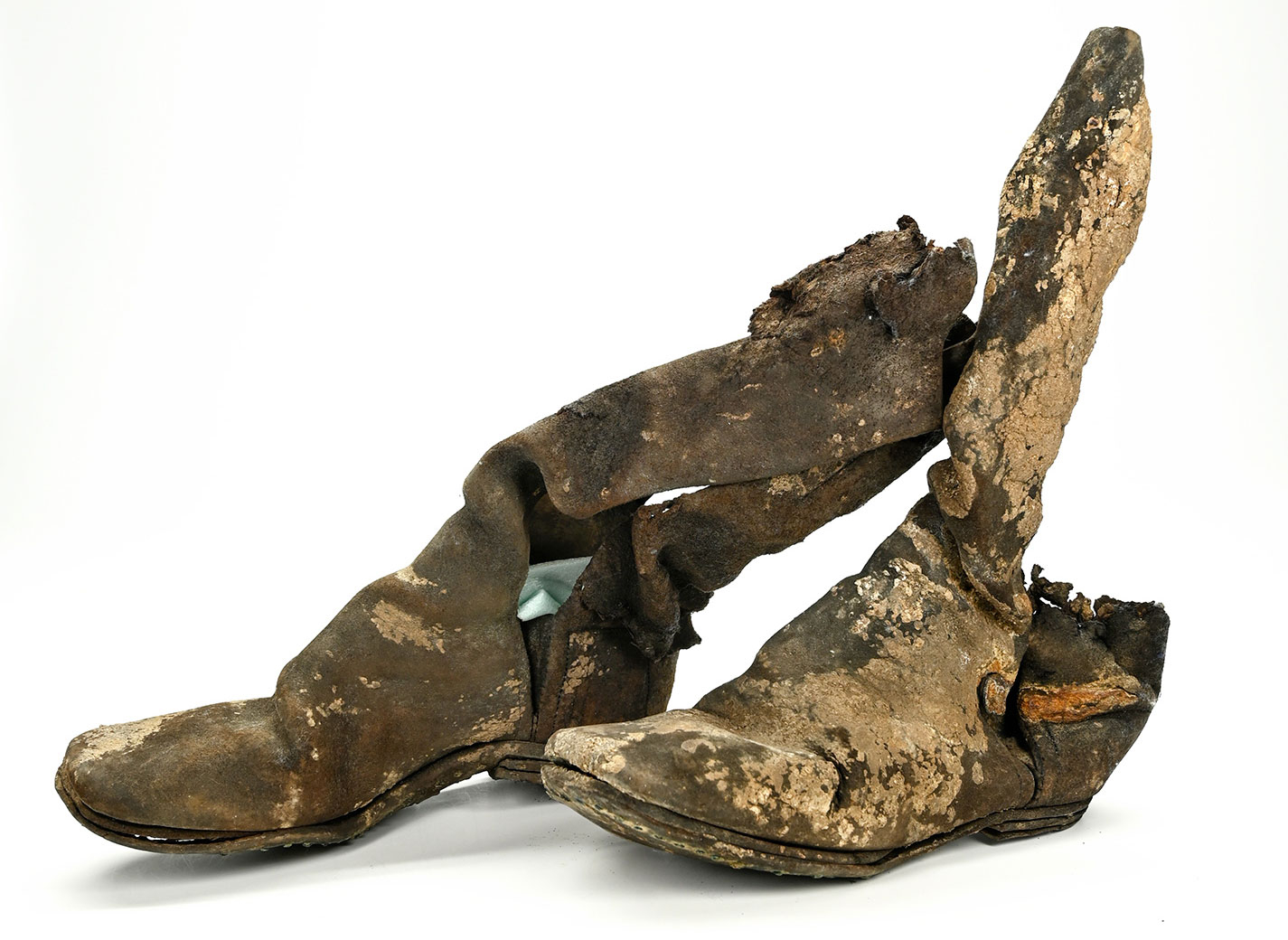site search
online catalog
PAIR EXCAVATED MODEL 1872 CAVALRY BOOTS: FORT PEMBINA

$225.00 ON HOLD
Quantity Available: 1
Item Code: 1052-546
The model 1872 cavalry boot replaced the Civil War issue boot with one having the same side seams to the leg and rough-side-out leather construction, but slightly taller and contoured slightly larger at the top to better allow trousers to be tucked into them, pull tabs mounted half inside and half outside the boot top, and using brass-screwed soles. These are relic condition, excavated, both with the foot portion intact, but one missing most of the back of the leg and the other being about full height but a bit ragged at the top. Both have seam separations, holes, wear to the soles, and missing heels, but show the brass screwed soles and other details of the pattern. Both are stiff and show stains. Nevertheless, they are good study pieces with a tight provenance to a small frontier army fort in operation from 1870 to 1895.
These were excavated at Fort Pembina, North Dakota, where anaerobic soil conditions have yielded both cloth and leather in remarkable states of preservation. (Excavations were done on private property with the owner’s permission.) The fort was situated in the Red River Valley in North Dakota near the Canadian border. Trading posts existed earlier in the area as part of the fur trade, and the first U.S. military post there was temporary- manned by a detachment of Minnesota troops in 1863-1864 following the 1862 Sioux uprising. In March 1870 a new fort was established south of the Pembina River and about 200 yards west of the Red River, completed by July and named in honor of Gen. George H. Thomas. The name was changed to Fort Pembina in September and the initial garrison consisted of two companies of the 20th US Infantry. As was typical of the army at this period, the troops were uniformed and equipped from government stocks left over from the Civil War and gradually refitted over time as new patterns were adopted and issued.
The main purpose of the fort was to provide security for settlers worried about Sioux returning south from Canada, but much of their duty involved escorting boundary surveys along the Canadian border and preventing Fenian raids heading north into Canada. The post included enlistedmen’s barracks, officers’ quarters, guard house, ordnance storehouse, company kitchen, root house, laundress’s quarters, quarters for civilian employees, hospital and hospital servant’s house, a barn for the “hospital cow,” quartermaster and commissary offices and storehouse, stables, wagon shed, etc. The garrison reached peak strength in 1878 of 200, but the average was about 125 enlisted men and 8 officers. An October 1885 return listed 97 men, 2 field pieces, 1 mountain howitzer, 100 rifles, 19 pistols, 23 mules, and 9 wagons. By 1890 the post had just 23 men, and after an 1895 fire destroyed some 19 buildings it was decided to abandon the fort rather than rebuild. The last detachment left in September, the property was turned over to the Interior Department, and later sold in 1902.
Army issue cavalry boots of any period are scarce and the early Indian War pattern is particularly so. [sr] [ph:m]
~~~~~~~~~~~~~~~~~~~~~~~~~~~~~~~~~~~
THIS ITEM, AS WITH ALL OTHER ITEMS AVAILABLE ON OUR WEB SITE,
MAY BE PURCHASED THROUGH OUR LAYAWAY PROGRAM.
CLICK HERE FOR OUR POLICIES AND TERMS.
THANK YOU!
Inquire About PAIR EXCAVATED MODEL 1872 CAVALRY BOOTS: FORT PEMBINA
For inquiries, please email us at [email protected]
Most Popular
Historical Firearms Stolen From The National Civil War Museum In Harrisburg, Pa »
Theft From Gravesite Of Gen. John Reynolds »
Cavalry Carbine Sling Swivel »
Fine Condition Brass Infantry Bugle Insignia »
featured item
VERY RARE REVOLUTIONARY WAR 84th REGIMENT, ROYAL HIGHLAND EMIGRANTS, CARTRIDGE BOX PLATE, ONE OF FIVE KNOWN
This is one of five known examples of the rare cartridge box plate worn by the Royal Highland Emigrants, the 84th Regiment of Foot, in the Revolutionary War. These are identical to the plates worn by the 71st Regiment and were certainly produced by… (844-32). Learn More »



